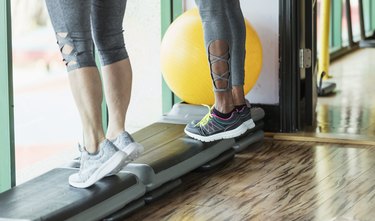Like crunches, standing calf raises get way more credit than they deserve. In fact, this exercise probably won't give you the strength or muscle size you're looking for — really, they're kind of a waste of your time.
Instead, Sam Chan, DPT, CSCS, physical therapist at Bespoke Treatments in New York City shares some of his favorite weighted and plyometric calf exercises that will give these muscles a more well-rounded and effective workout.
Video of the Day
Video of the Day
2 Calf Exercises to Skip During Your Next Leg Workout
1. Standing Calf Raise
Standing calf raises are probably the most common calf exercise and can be one of the most ineffective, too. Performing calf raises from the floor prevents your muscle from moving through its full range of motion, Chan says.
Even though you may be contracting your calf muscle at the top of the exercise, getting full movement is crucial if you want to build serious strength and size. Plus, performing calf raises on the floor makes it easy to use a bounce or use momentum to get through the reps, taking the work out of your calves, Chan says.
2. Calf Raise on a Leg Press Machine
While the leg press machine is meant to mainly target your quads, there are some gym-goers who use the machine for calf raises. But unfortunately, this move won't actually do much to strengthen your calf muscles.
For any strength-building exercise, you need to press the weight against gravity, otherwise the move won't be effective. So, since they don't involve much pushing against gravity, leg press calf raises probably won't provide enough resistance to the muscles, Chan says.
"It may require a lot of weight to be loaded onto the leg press machine to really get to the point where your calves will be challenged," he says. "However, this might be dangerous, as your knees will be at risk of hyperextending during the exercise."
4 Calf Exercises to Do Instead
1. Weighted Deficit Calf Raise
If you're really committed to calf raises, working off a step is more beneficial, Chan says. This will allow the calf to stretch at the bottom of the motion, allowing you to work the full range of motion.
- Stand on the balls of your feet at the edge of a step or other raised platform.
- Hold a pair of dumbbells or a kettlebell in your hands. Keep your knees straight.
- Lower your heels a few inches toward the floor.
- Press through the balls of your feet and raise up as high as possible, elevating the heels toward the sky.
- Pause here for a second.
- Fully lower your heels toward the floor so your calves are in a stretch.
- Pause here for a moment.
- Return to the middle position and repeat.
Tip
Don't be afraid to load this exercise with some heavy weight. "The calves have a great endurance and are very fatigue resistance, so you need to be working at a higher rep scheme than most of your other exercises in order to stimulate growth," Chan says. You also want to avoid bouncing your feet from the ground when performing this exercise. One way you can really hone in on your calves and prevent muscle imbalances is to work one foot at a time.
2. Seated Soleus Press
- Start seated on a chair with your toes elevated on a step or barbell plate. Place a weight in your lap.
- Lower your heels a few inches toward the floor.
- Press your toes into the step and raise your heels up toward the sky, raising the weight. Pause here for a moment.
- Fully lower your heels toward the floor so that the calves are stretched. Pause here.
- Return to the starting position for your next rep.
3. Single-Leg Box Jump
- Stand in front of a low box or step.
- Standing on your right leg, slightly bend your hips and knees, bringing your arms behind you.
- Swing your arms forward and up, landing on top of the box with your right leg.
- Step off the box carefully and repeat.
- Once you finish all your reps, repeat on the opposite side.
Tip
To build your calves, you want to work both your fast and slow-twitch muscle fibers, Chan explains. While slower exercises (like calf raises) will train the slow-twitch fibers, plyo exercises (like box jumps) will improve the fast-twitch.
"Throwing in some plyometrics will train and strengthen the calves in a more well-rounded manner," Chan says.
This is an advanced exercise and is meant for those who feel very confident in their balance and strength, so if you're new to box jumps, use both legs first.
4. Sled March
- Load a sled with weight plates.
- Holding each handle, come up onto your toes, keeping your heels high in the air.
- Drive your toes into the ground and lean into the sled, pushing the weight forward.
- With each step, keep the heels raised, calves contracted and ankles stiff.
Tip
The goal here is to push the sled without letting your calves lower toward the ground. This exercise is a great way to isometrically strengthen your calves by holding the muscle in a contracted position, Chan says. Plus, your glutes, quads and hamstrings will also get a piece of the action.
